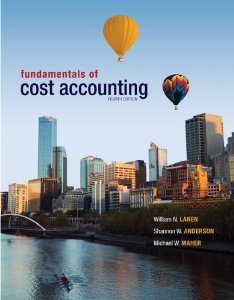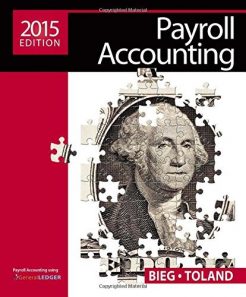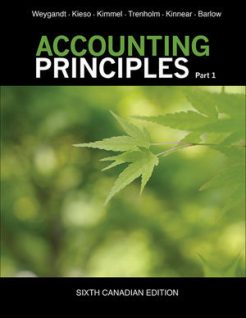Description
solutions manual Fundamentals of Cost Accounting Lanen Anderson Maher 4th Edition
Delivery is INSTANT. You can download the files IMMEDIATELY once payment is done
If you have any questions, or would like a receive a sample chapter before your purchase, please contact us at inquiry@testbankcorp.com
Table of Contents
Chapter 1: Cost Accounting: Information for Decision Making
Chapter 2: Cost Concepts and Behavior
Chapter 3: Fundamentals of Cost-Volume-Profit Analysis
Chapter 4: Fundamentals of Cost Analysis for Decision Making
Chapter 5: Cost Estimation
Chapter 6: Fundamentals of Product and Service Costing
Chapter 7: Job Costing
Chapter 8: Process Costing
Chapter 9: Activity-Based Costing
Chapter 10: Fundamentals of Cost Management
Chapter 11: Service Department and Joint Cost Allocation
Chapter 12: Fundamentals of Management Control Systems
Chapter 13: Planning and Budgeting
Chapter 14: Business Unit Performance Measurement
Chapter 15: Transfer Pricing
Chapter 16: Fundamentals of Variance Analysis
Chapter 17: Additional Topics in Variance Analysis
Chapter 18: Performance Measurement to Support Business Strategy
Appendix: Capital Investment Decisions: An Overview
Please note that the files are compressed using the program Winzip.
Files ending with the extension (.pdf) can be opened using Adobe Acrobat Reader.
Chapter 4
Fundamentals of Cost Analysis for Decision Making
Solutions to Review Questions
4-1.
Costs that are “fixed in the short run” are usually not fixed in the long run. In fact few, if any, costs are fixed over a very long time horizon.
4-2.
A sunk cost has taken place in the past and cannot be changed. A differential cost is one that will change with a given decision.
4-3.
Strictly speaking, sunk costs can never be differential costs. However, sunk costs can determine the amounts of certain differential costs. For example, federal income taxes are based on historical (sunk) costs. The disposal of a fixed asset may result in a tax based on the difference between the sales proceeds and the undepreciated sunk cost. Many contracts are based on sunk costs as well. Decisions may have contract implications that arise with changes in plans.
4-4.
Short-run decisions affect operations within one year (for example, the decision to accept a special order). Long-run decisions affect operations for greater than one year (for example, expansion of plant capacity).
4-5.
The full cost of a product is the sum of all fixed and variable costs of manufacturing and selling a unit. Full cost is not always appropriate for making decisions—especially short-run decisions. Fixed costs are often irrelevant for short-run decisions (i.e., fixed costs often remain unchanged from the status quo to the alternative).
4-6.
The product life cycle covers the time from initial research and development to the time at which support to the customer is withdrawn. Managers estimate revenues and costs throughout the product’s life cycle to make pricing decisions. Life-cycle costs include not only the costs of development and production, but also the costs of maintenance and disposal.
4-7.
Cost-plus pricing is most likely to be used for unique products where no market price information exists—areas like construction jobs, defense contracts, and custom orders.
4-8.
Target cost is the target price minus some desired profit margin. Target price is a price set by management based on customers’ perceived value for the product and the price competitors charge. There are four steps to developing target prices and target costs:
1. Develop a product that satisfies the needs of potential customers.
2. Choose a target price based on consumers’ perceived value of the product and competitor’s prices.
3. Derive a target cost by subtracting the desired profit margin from the target price.
4. Perform value engineering to achieve target costs.
4-9.
Predatory pricing is the practice of a setting a selling price at a low price with the intent of driving competitors out of the market or of creating a barrier to entry for new competitors.
Predatory pricing is illegal in many jurisdictions because, although there might be a short-term benefit to consumers, as competitors are driven out of the market, the firm practicing predatory pricing is able to act as a monoploly.
4-10.
Dumping is the practice of exporting products to consumers in another country at an export price below the domestic price. A cost accountant would help determine the cost of the product and the costs of exporting versus distributing the product domestically.
4-11.
Price discrimination is the practice of selling identical goods or services to different customers at different prices. A cost accountant would help determine the costs of providing the product to different customers. Examples of costs that might differ would be support costs (for example, for software) or distribution costs (for example, for urban versus rural consumers).
4-12.
Unit gross margins are typically computed with an allocation of fixed costs. Total fixed costs generally will not change with a change in volume within the relevant range. Unitizing the fixed costs results in treating them as though they are variable costs when, in fact, they are not. Moreover, when multiple products are manufactured, the relative contribution becomes the criterion for selecting the optimal product mix. Fixed costs allocations can distort the relative contributions and result in a suboptimal decision.
4-13.
The company should compute the contribution margin of each product per unit of the constraining resource. It should rank the products from highest to lowest contribution margin per unit of constraining resource, then produce the products in order of this value.
4-14.
Production constraints mean that managers have to consider the opportunity cost of using production resources. Producing one unit of Product A means that less of Product B can be produced. The lost contribution from selling Product B is an opportunity cost of producing Product A. The optimal product mix is the one that maximizes the total contribution margin from all products subject to the constraints.
4-15.
Common nonfinancial considerations that are important in deciding to drop a product line include the effect on employees that work on that line, the impact on sales of other products if it is important to be known as a company that can produce the product dropped, the effect on the community from possible plant closings, and so on.
4-16.
The theory of constraints focuses on these three factors:
1. Throughput contribution: Sales dollars minus direct materials and other variable costs.
2. Investments: Inventories, equipment, buildings, and other assets used to generate throughput contribution.
3. Operating costs: All operating costs other than direct materials and other variable costs.
?
Solutions to Critical Analysis and Discussion Questions
4-17.
The main differential costs are the rent and the additional commission. Staff salaries and the other costs of providing mortgages would not be differential.
4-18.
The remaining lease costs are sunk (assuming the company cannot sublet the space), so they are not relevant to the decision.
4-19.
Although the variable cost of a passenger is very low, airlines do not usually price literally at variable cost, even at the last minute. One reason is that this would lead all passengers to try this approach. The accounting system does not record this type of cost.
4-20.
Because the telephones are obsolete, the new price might reflect the value consumers place on them. It is unlikely that the low price on obsolete equipment will drive competitors from the market. This is not predatory pricing.
4-21.
This is price discrimination. The airlines are able to segment customers who are more sensitive to the schedule or to knowing travel plans in advance.
4-22.
From the article it is not clear what go!’s costs actually are, so it is not possible to say whether or not this was predatory pricing. It is also not clear what the intent of the pricing plan is.
4-23.
Variable costs are usually relevant when talking about changes in production volumes. However, if the change in production volume extends beyond the “relevant range,” some fixed costs may also be differential. In addition, there are opportunity costs that may be differential for a certain decision. In some cases there may be no change in variable costs. For example, if a company were to add a second copier in the office workroom to expedite copying, the number of copies produced would be unchanged, but the fixed costs of the equipment would approximately double.
4-24.
In the short run, sales revenues need only cover the differential costs of production and sale. So, from a short-run perspective, so long as the sale does not affect other output prices or normal sales volume, a “below cost” sale may result in a net increase in income so long as the revenues cover the differential costs. However, in the long run all costs must be covered or management would not reinvest in the same type of assets. If the company must continually sell below the full cost of production then it will most likely get out of that particular business when it comes time to replace those facilities.
4-25.
This is a difficult and complex issue, so the purpose of this question is to stimulate discussion and have students think about the complexities of using incremental costs as a basis for decision making.
Assuming the passenger who is upgraded is not replaced by another economy passenger, the differential costs are the costs of any incremental food and beverage served in first class. If the passenger is replaced, the differential costs would be the costs of the beverages and meals in first class, plus the additional fuel required for the additional passenger and associated baggage.
The opportunity cost includes any revenue lost from a last-minute customer willing to pay for first class, if the upgraded seat is the last one taken. The opportunity costs of not upgrading the passenger is the possible lost revenue (profit) to the airline, if the elite passenger becomes unhappy and shift business to another airline.
4-26.
The differential costs include:
• Fuel
• Wear and tear related to miles driven such as tires, mileage-related maintenance, lube and oil
• Parking and tolls, if any
• Car wash if needed due to the trip
• Risk of casualties that vary with mileage
• Other costs that vary with mileage
?
4-27.
The differential costs include:
• Cost of the car
• Forgone interest income on funds paid for the car
• Interest on debt on the car
• Insurance
• Maintenance that is time-related
• License and taxes
These costs are different than the costs in 4-26. The costs in 4-26 are those required to operate the car for an additional few miles. The costs that vary with the number of cars do not vary with mileage. The costs in 4-27 vary with the number of cars and not with the miles driven.
Of course, there is the possibility that if you buy a new car you will be asked to drive your friends around more often than otherwise.
4-28.
This approach will maximize profits only if there are no constraints on production or sales, or if both products use all scarce resources at an equal rate. Otherwise management would want to maximize the contribution per unit of scarce resource.
4-29.
Fixed costs are relevant anytime they change with the product-mix decision. For example, if there are fixed costs that can be eliminated with the elimination of one or more of the individual products, then those fixed costs might be relevant in a multi-product setting. They would be relevant if the contribution from production of any one product was insufficient to cover the fixed costs that could be eliminated.
4-30.
Performance can be improved at the bottleneck by increasing capacity or shifting resources from non-bottleneck areas to the bottleneck.
4-31.
Profits can be increased by decreasing investments, increasing throughput, and decreasing operating expenses. Most who subscribe to the theory of constraints focus on increasing throughput contribution.







Reviews
There are no reviews yet.